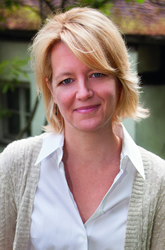In 1991, the Soviet Union collapsed, and Ukraine became an independent country. This, for author and professor Wendy Lower, left many questions on German history unanswered and many archives on the Holocaust undiscovered.
“The question remained, what about all those regional offices where the Germans had set up their operations in Ukraine, Belarus and the Baltics, where these crimes had occurred?” Lower, who teaches at Claremont-McKenna College, said. “What was going on out there in the field?”
But when Lower went to Ukraine during the summer of 1992, the archives in the former Soviet Union revealed a different story – one involving the lives of ordinary German women during the Holocaust.
What she found then inspired her most recent book, Hitler’s Furies: German Women in the Nazi Killing Fields, which focuses on the German women’s equal but previously ignored involvement in the Holocaust.
Lower spoke about her book on Oct. 26, at the Burton C. Einspruch Holocaust Lecture Series, which the Ackerman Center for Holocaust Studies hosts annually.
The Ackerman Center for Holocaust Studies program is a part of the School of Arts and Humanities and includes a certificate in Holocaust studies, graduate and undergraduate courses, fellowship support for graduate students and the Arnold A. Jaffe Holocaust Library Collection.
“It really took the collapse of the Soviet Union for us to not only get access to those materials and to get into those archives, but to start to really imagine and understand the scope of the violence that was occurring in these open-air settings outside the killing centers,” Lower said.
The program founder and director, Zsuzsanna Ozsvath, is a Holocaust survivor and has taught classes at UTD on the history of and literature from the Holocaust since 1983. As the classes gained supporters such as the Ackerman Challenge Endowment, they developed into a working program, Ozsvath said.
Ozsvath, who earned a Ph.D. in German language and literature from UT Austin, has focused her research on attempting to study and understand what happened leading to the Holocaust. She said she has come to understand the vulnerability of the German people after World War I, the political circumstances that lead to World War II and why so many German soldiers weren’t punished for their roles in the Holocaust.
Despite this understanding, she said she still struggles to grasp the concept that some races are inferior to others and therefore, deserve to be eliminated.
“It is very difficult to have a just world, without knowing how an unjust world could have come to power, defeating every decent thinking man and woman, misleading our children and creating a government and a system that was set on the one hand to eliminate the Jews, the Gypsy, the Slavic and everyone who was thought as less valuable as the Germans were,” Ozsvath said.
The purpose of the program is to study the past, in hopes of understanding it and preventing it from repeating itself.
“To understand the past, it means to teach the future,” Ozsvath said.
Not everyone will agree with history, but knowing everything that happened is necessary to contain it, she said.
But teaching tragedy is often challenging, Ozsvath said, particularly when it is one that cannot be healed.
It is difficult to teach the Holocaust, she said, because America is built on the belief that when life is hard, one can overcome it; each American child is raised to believe that from the day he or she is born.
This is difficult to apply to the Holocaust, Ozsvath said.
“A person lost her mother, father, her husband and all her brothers and sisters,” Ozsvath said. “There is nothing that you can overcome or that you have in your hands that good attitude can change.”
When studying the Holocaust, the blame is easily placed on men who have evidently played a part in the war and mass killings as soldiers, she said.
German women, on the other hand, weren’t soldiers, and as a result, aren’t given much thought in their involvement.
The women may not have been soldiers, but they were typists and nurses and all kinds of other professions, which took them to the front where the major killings occurred, Ozsvath said.
This didn’t occur to Lower until she found the documents that included a number of testimonies the women had given.
“She’s telling me every detail about the procedures that were taken, how orders were conveyed to kill units, who had access to classified material, identifying killers and often describing scenes at the killing sights,” Lower said. “We never asked, ‘how come they know so much?’”
Lower said she was able to account for half a million German women who circulated in the eastern territory – 400,000 of them in war service.
Knowing this and the many sides of 20th-century history is a step to understanding your existing life, Ozsvath said.
“It is so much a part of the past that it is not 100 percent gone yet,” Ozsvath said.
“You can say by knowing what has happened, you are going to watch out and understand that you can never make such a mistake in who you elect.”







